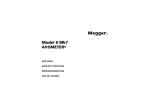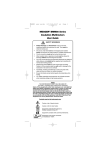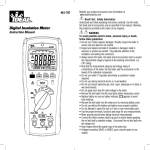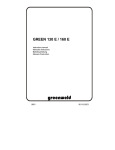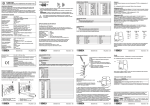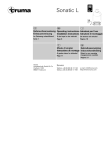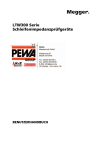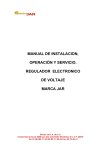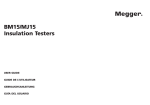Download User Guide Guide de l`utilisateur Gebrauchsanleitung Guía del usuario
Transcript
500 V. Analogue Insulation & Continuity Testers MEGGER® BM100/4 and BM101/4 User Guide Guide de l’utilisateur Gebrauchsanleitung Guía del usuario SAFETY WARNINGS ✱ Safety Warnings and precautions must be read and understood before the instrument is used. They must be observed during use. ✱ The circuit under test must be de-energised and isolated before Insulation, Resistance, or Continuity tests are made. ✱ During an insulation test, the circuit must not be touched. ✱ After insulation tests, capacitive circuits must be allowed to discharge before disconnecting the test leads. ✱ Test leads, including prods and crocodile clips must be in good order; clean, and with no broken or cracked insulation. ✱ Replacement fuses must be of the correct type and rating. BM 100/4 Only ✱ U.K. Safety Authorities recommend the use of fused test leads when measuring voltage on high energy systems. ✱ When making a voltage measurement, the 'Test' push must not be pressed. NOTE THE INSTRUMENTS MUST ONY BE USED BY SUITABLY TRAINED AND COMPETENT PERSONS. Symbols used on the instrument Caution: Refer to accompanying notes. Equipment protected throughout by Double Insulation (Class II). Equipment complies with relevant EU Directives Refer to Safety Warnings before using the instrument OPERATION Preliminary Test lead check 1. Before each use of the instrument, inspect the test leads to confirm that their condition is good, with no damaged or broken insulation. 2. Insert the red and black test leads, terminated with the appropriate prods or clips, to their respective ‘+’ and ‘-’ terminal sockets. 3. Short the test lead prods or clips together. Set the selector switch to ‘2 ’. 4. Press the ‘Test’ push. Check that the instrument reads zero. If a higher resistance reading is obtained check all connections. If the reading remains high, suspect that the test leads may be at fault, or that the 2A non replaceable fuse has ruptured. Continuity Testing 1. Set the selector switch to ‘2 ’, or ‘200 ’, as appropriate. 2. Connect the test leads across the isolated item / circuit under test. 3. Press and hold the ‘Test’ push button; allow the needle to settle. There is a separate scale for each range so each reading is direct. Take the reading from the appropriate scale of the instrument. 4. Release the ‘Test’ push button and disconnect the test leads. Insulation Testing 1. Set the selector switch to ‘200 MΩ.’ 2. Connect the Red test lead to earth, equipment frame, or cable sheath etc. 3. Connect the Black test lead to the circuit under test or cable core. 4. Confirm that Voltage is not indicated on the instrument. (BM100/4 only) 5. Press and hold the ‘Test’ push; allow needle to settle, and take the reading from the top scale of the instrument. 6. 7. Release the ‘Test’ push button. Wait a few moments before disconnecting the test leads, to allow any circuit capacitance to discharge. The BM100/4 will automatically monitor the discharge on its Voltage range, indicating when it is safe to remove the test leads. Resistance Testing (BM101/4 only) 1. Set the selector switch to the 1MΩ resistance range. 2. Connect the test leads across the isolated item / circuit under test. 3. Press and hold the ‘Test’ push button, allow the needle to settle. Take the reading from the 1MΩ range scale. 4. Release the ‘Test’ push button and disconnect the test leads. SPECIFICATION Range: Insulation Resistance Continuity BM100/4 (¡) (¡¡) Insulation Test Voltage: BM101/4 0,01 - 200 MΩ 0,01 - 200 Ω 0,01 - 2 Ω 0,01 - 200 MΩ 0,01 - 1 MΩ 0,01 - 200 Ω 0,01 - 2 Ω 500V d.c. 500V d.c. <600V d.c. <600V d.c. Open Cct. Terminal Voltage: Insulation Range Resistance Range Continuity Ranges (¡) (¡¡) (>500V at 0,5MΩ) >500V at 0,5MΩ) 0,76V d.c.(nom.) 53V d.c.(nom.) 0,76V d.c.(nom) 4,7V d.c.(nom.) 4,7V d.c.(nom) Typical Terminal Characteristics Short Cct.Terminal Current: Insulation Range Resistance Range Continuity Ranges (¡) (¡¡) Movement: Limiting value curve 1,6 mA 1,6 mA - 325 µA 12,3 mA 12,3 mA 217 mA 217 mA Robust Taut Band type. 250 µA F.S.D. A.C. Voltage Measurement (BM100/4 only): The Voltage range is automatically selected when the switch is in any position and the ‘Test’ push button is not pressed. When connected across the circuit under test, the BM100/4 will indicate if the circuit is energised (a.c. or d.c.), and measure a.c.voltage up to 600 V. Voltmeter Input Impedance: 330 kΩ Automatic Discharge: Capacitive circuits are automatically discharged via an internal (<500kΩ) resistor, when the ‘Test' push button is released following an insulation test. Accuracy (at 20°C): ± 2,5% of scale length on all ranges (e.g.± 1,9 mm on Insulation range). Insulation range is marked with a white band (Class 1,5 as VDE 0413). Other ranges are Class 3. Humidity: Operation: 90% R.H.max. at 20°C 80% R.H. max.at 35°C Storage 95% R.H. max. at 35°C Temperature Range: Operation: -5°C to + 40°C Storage -20°C to + 70°C Temperature Coefficient: ±0,1% per °C Power Supply: Single 9V Alkaline battery I.E.C. 6 LR61 type Current consumption: 110 mA max on Insulation 40mA max on Resistance 220 mA max on 2 Ω range Battery life: Not less than 1800, 5 second operations on 2Ω range. Battery Condition Test: The battery condition test position checks the battery voltage on a simulated load, when the ‘Test’ push button is pressed. The instrument pointer should deflect clockwise to within the ‘Battery Check’ arc on the scale. Remove the battery if the instrument is not to be used for an extended period of time. Battery Replacement: For safety reasons, the battery compartment must not be opened if the test leads are connected. To remove the battery cover, release the screw in the centre of the cover and lever the cover upwards. Replaceable Fuse: 500 mA, 250V. H.B.C. type (F) (20mm. x 5mm) To check this fuse, open circuit the test leads, switch to the 200 range and press the ‘Test’ push button. A reading of <200Ω indicates a ruptured fuse. Located in the battery compartment, this fuse can be replaced by the user. The replacement fuse must be of the correct type and rating.To replace the fuse, disconnect the test leads, remove the battery cover by releasing the screw in the centre of the cover and levering the cover upwards. A spare fuse is clipped onto the battery cover. Non Replaceable Fuse: 2A- 500 V H.B.C. type (F) 50 kA. Fitted for overall safety protection, this fuse is not replaceable by the user. No response from the instrument to an insulation test, with the leads shorted together is likely to mean that this fuse has ruptured. The instrument must be returned to the manufacturer, or an approved agent for repair. Safety: Meets the requirements for double insulation to IEC1010-1 (1995) EN61010-1 (1995) to installation Category III***, 300 V phase to earth (ground) and 500 V phase to phase, without the need for separately fused test leads. If required, fused test leads are available as an optional accessory. Indicates circuit discharge after insulation test, 600 V Category II **. *** Relates to transient overvoltage likely to be found in fixed installation wiring. ** Relates to transient overvoltage likely to be found in portable equipment and appliances. E.M.C. Meets EN 50081-1 and EN 50082-1 (1992) Standards: BS 7430 (1992) Weight: - VDE 0413 (1982) 485g Dimensions: 175 mm x 95 mm x 57 mm. Cleaning: Wipe disconnected instrument with a clean cloth dampened with soapy water or Isopropyl Alcohol (IPA). ACCESSORIES Supplied Test lead set and User Guide Part Number Optional Synthetic Test & carry case 4mm. Right angled adaptor - Black: 4mm. Right angled adaptor - Red: (enabling use of leads with straight connectors). Test lead set with fused prods. (Not recommended for continuity tests). Publications ‘A Stitch in Time’ 6420- 030 6320-176 6320-177 6110-920 AVTM21-P8B REPAIR AND WARRANTY The instrument circuit contains static sensitive devices, and care must be taken in handling the printed circuit board. If the protection of an instrument has been impaired it should not be used, and be sent for repair by suitably trained and qualified personnel. The protection is likely to be impaired if, for example, the instrument shows visible damage, fails to perform the intended measurements, has been subjected to prolonged storage under unfavourable conditions, or has been exposed to severe transport stresses. New Instruments are Guaranteed for 1 Year from the Date of Purchase by the User. Note: Any unauthorized prior repair or adjustment will automatically invalidate the Warranty. Instrument Repair and Spare Parts For service requirements for MEGGER® Instruments contact :AVO INTERNATIONAL Archcliffe Road or AVO INTERNATIONAL Valley Forge Corporate Center Dover 2621 Van Buren Avenue Kent, CT17 9EN England Norristown, PA 19403 U.S.A. Tel: +44 (0) 1304 502243 Fax: +44 (0) 1304 207342 or an approved repair company. Tel: +1 (610) 676-8500 Fax: +1 (610) 643-8625 Approved Repair Companies Anumber of independent instrument repair companies have been approved for repair work on most MEGGER® instruments, using genuine MEGGER® spare parts. Consult the Appointed Distributor / Agent regarding spare parts, repair facilities and advice on the best course of action to take. Returning an Instrument for Repair If returning an instrument to the manufacturer for repair, it should be sent freight pre-paid to the appropriate address. Acopy of the Invoice and of the packing note should be sent simultaneously by airmail to expedite clearance through Customs. A repair estimate showing freight return and other charges will be submitted to the sender, if required, before work on the instrument commences. AVO INTERNATIONAL Archcliffe Road Dover Kent, CT17 9EN. England. Tel: + 44 (0) 1304 502100 Fax: + 44 (0) 1304 207342 4271 Bronze Way Dallas TX 75237-1017 U.S.A. Tel: +1 (800) 723-2861 (U.S.A. only) Tel: +1 (214) 330-3203 (International) Fax: +1 (214) 337-3038 PO Box 9007 Valley Forge PA 19484-9007 U.S.A. Tel: +1 (610) 676-8500 Fax: +1 (610) 676-8610 MEGGER SARL 29 Allée de Villemomble, 93340 Le Raincy Paris France Tel: +33 (1) 43.02.37.54 Fax: +33 (1) 43.02.16.24 Note Users of this equipment and or their employers are reminded that Health and Safety Legislation require them to carry out valid risk assessments of all electrical work so as to identify potential sources of electrical danger and risk of electrical injury such as from inadvertent short circuits. Where the assessments show that the risk is significant then the use of fused test leads constructed in accordance with the HSE guidance note GS38 ‘Electrical Test Equipment for use by Electricians’should be used. This Instrument is manufactured in the United Kingdom. The Company reserves the right to change the specification or design without prior notice. MEGGER is the registered Trade Mark of AVO INTERNATIONALLIMITED. Copyright©, AVO INTERNATIONALLIMITED. Part No 6172 - 048 - Edition 7 - Printed in England - 10GG Guide de l’utilisateur Consignes de Securité ✱ Vous devez lire les consignes de sécurité et les précautions et bien les comprendre avant de vous servir de cet instrument. Respectez ces consignes et précautions lors de l'utilisation de cet appareil. ✱ Débranchez, désexcitez et isolez le circuit que vous comptez tester avant d'effectuer les connexions nécessaires aux essais d'isolement et de continuité. ✱ Ne touchez pas aux branchements de circuits et aux éléments métalliques exposés d'une installation ou d'un équipement à l'essai. ✱ Après des essais d'isolement, attendez que les circuits capacitifs se déchargent avant de débrancher les conducteurs d'essai. ✱ Les conducteurs d'essai, les palpeurs et les pinces crocodile doivent être en parfait état et propres et leur isolation ne doit pas être fissurée ou cassée. ✱ Les fusibles de rechange doivent être du type correct et offrir le pouvoir de coupure prévu. BM 100/4 seulement ✱ ✱ Les organismes officiels britanniques chargés de la sécurité recommandent l'utilisation de conducteurs d'essai protégés par un fusible pour mesurer la tension de circuits à forte énergie. Lors d’une mesure de tension, le bouton de ‘TEST‘ ne doit pas etre enfoncé. NOTA L’INSTRUMENT NE DOIT ÊTRE UTILISE QUE PAR DES PERSONNES COMPETENTES ET FORMÉE Vérifications préliminaires des conducteurs d’essai. 1. Avant chaque utilisation de l’instrument, examinez les conducteurs d’essai pour vous assurer qu’ils sont en bon état et que leur isolation n’est pas endommagée ou cassée. 2. Introduisez les conducteurs d’essai rouges et noirs qui se terminent par des pinces ou pointes de contact de type approprié, dans les prises femelles respectives des bornes ‘+‘ et ‘-‘. 3. Reliez l’une à l’autre les pinces ou les pointes de contact des conducteurs d’essai puis réglez le sélecteur sur la plage ‘2 ‘. 4. Appuyez sur le bouton-poussoir ‘Test‘ pour vérifier que l’instrument affiche une valeur égale à ‘ 0‘. Vérifiez tous les branchements si vous obtenez une résistance plus élevée. Si la valeur affichée reste importante, il est probable que les conducteurs d’essai sont défectueux ou que le fusible de 2 A qui n’est pas remplaçable a sauté. Voir les Avertissement de Sécurité avant d’utiliser l’instrument Essais d’Isolement 1. Amenez le sélecteur sur la plage ’200 M ‘. 2. Branchez les conducteurs d’essai sur l’article ou le circuit isolé à tester. 3.Branchez le conducteur d’essai rouge à la terre: le châssis de l’équipement ou la gaine d’un câble, etc. 4.Branchez le conducteur d’essai noir sur le circuit testé ou sur le conducteur de câble. 5. Confirmez que l’instrument n’affiche pas une tension (BM100/4 uniquement). 6. Appuyez sur le bouton-poussoir ‘Test‘. Maintenez la pression sur ce bouton. Attendez que l’aiguille se stabilise puis effectuez une mesure en utilisant l’échelle supérieure de l’instrument. 7.Relâchez le bouton-poussoir ‘Test‘. 8.Attendez quelques instants avant de débrancher les conducteurs d’essai afin de permettre à la capacitance du circuit de se décharger. L’appareil BM100/4 contrôle automatiquement la décharge sur la plage de tension et vous indique le moment où vous pouvez retirer sans danger les conducteurs d’essai. Essais de Continuité 1. Amenez le sélecteur sur la plage ‘2 ‘ ou ‘200 ‘, suivant les cas. 2. Branchez les conducteurs d’essai aux bornes du circuit testé. 3.Appuyez sur le bouton-poussoir ‘Test‘. Maintenez la pression sur ce bouton. Attendez que l’aiguille se stabilise. Il y a une échelle séparée pour chaque plage. Par conséquent, la lecture est directe. Notez la valeur affichée sur l’échelle appropriée de l’instrument. 4.Relâchez le bouton-poussoir ‘Test‘ puis débranchez les conducteurs d’essai. Essais de Résistance (modèle BM101/4 uniquement) 1. Amenez le sélecteur sur la plage de résistance de 1 M . 2.Branchez les conducteurs d’essai aux bornes du circuit testé. 3.Appuyez sur le bouton-poussoir ‘Test‘. Maintenez la pression sur ce bouton. Attendez que l’aiguille se stabilise. Notez la valeur affichée sur l’échelle de la plage de 1 M . 4.Relâchez le bouton-poussoir ‘Test‘ puis débranchez les conducteurs d’essai. Essais de Tension (Modèle BM 100/4 uniquement) La plage de tension est automatiquement sélectionnée, quelle que soit la position occupée par le sélecteur, tant que vous n’appuyez pas sur le bouton-poussoir ‘Test‘. L’organisme officiel de sécurité de GrandeBretagne recommande d’utiliser, pour ce type d’activités, des conducteurs d’essai protégés par des fusibles. 1. Branchez les conducteurs d’essai aux bornes du circuit testé. 2. L’instrument indique que ce circuit est excité et la tension présente Gebrauchsanleitung Hinweise zur Betriebssicherheit ✱ Die Sicherheitshinweise und Vorsichtsmaßnahmen müssen vor Einsatz des Geräts gelesen und verstanden worden sein und während des Einsatzes beachtet werden. ✱ Der zu prüfende Schaltkreis muß vor Herstellen der Verbindungen zum Prüfen der Isolation oder des Durchgangs abgeschaltet, energielos gemacht und isoliert werden. ✱ Während des Prüfens dürfen Schaltkreisanschlüsse und freiliegende Metallteile einer Installation oder Anlage nicht berührt werden. ✱ Nach den Isolationsprüfungen und vor Abschluß der Meßkabel muß kapazitiven Schaltkreisen Gelegenheit gegeben werden, sich vollständig zu entladen. ✱ Meßkabel, Sonden und Krokodilklemmen müssen in gutem Zustand und sauber sein und dürfen keine gebrochene oder gespaltene Isolierung haben. ✱ Sicherungen müssen durch solche vom richtigen Typ und Nennwert ersetzt werden. Nur BM 100/4 ✱ Die britischen Sicherheitsbehörden empfehlen die Verwendung von abgesicherten Meßkabeln beim Messen von Spannungen an hochenergetischen Systemen. ✱ Bei Spannungsmessung Testtaste nicht drücken. ANMERKUNG DIESES INSTRUMENT DÜRFEN NUR VON AUSREICHEND GESCHULTEN UND KOMPETENTEN PERSONEN BEDIENT WERDEN Vorbereitende Prüfung der Meßkabel 1. Vor jedem Einsatz des Meßinstruments müssen die Meßkabel geprüft werden, um zu gewährleisten, daß sie sich in gutem Zustand befinden und die Isolierung weder beschädigt noch gebrochen ist. 2. Verbinden Sie die Stifte oder Klemmen des roten und des schwarze Meßkabels mit der Plus- bzw. Minusbuchse. 3. Verbinden Sie die Stifte oder Klemmen der Meßkabel miteinander und schalten Sie den Wählschalter auf ‘2 ‘. 4 Drücken Sie die Taste “Test” und prüfen Sie, ob das Meßinstrument ‘0‘ anzeigt. Prüfen Sie alle Verbindungen, wenn das Instrument einen höheren Widerstandswert anzeigt. Falls der Wert hoch bleibt, können Sie davon ausgehen, daß die Meßkabel fehlerhaft sind oder die nicht auswechselbare Sicherung von 2 Amp durchgebrannt ist. Wenden Sie sich vor dem Einsatz des Instruments an sie Sicherheitshinweise Isolationsprüfung 1. Schalten Sie den Wählschalter auf ‘200 M ‘. 2. Verbinden Sie die Meßkabel mit dem zu prüfenden Teil bzw. Schaltkreis. 3. Verbinden Sie das rote Meßkabel mit dem Erdungspol, dem Geräterahmen oder der Kabelabschirmung usw. 4. Verbinden Sie das schwarze Meßkabel mit dem zu prüfenden Schaltkreis oder der Kabelseele. 5. Achten Sie darauf, daß das Meßinstrument keine Spannung anzeigt (nur BM 100/4). 6. Halten Sie die Taste “Test” gedrückt, warten Sie, bis der Zeiger sich beruhigt hat und lesen Sie den auf der obersten Skala angezeigten Wert ab. 7.Lassen Sie die Taste ‘Test‘ los. 8. Warten Sie einige Sekunden, bevor Sie die Meßkabel abklemmen, damit sich eventuell verbliebene Leiterkapazität entladen kann. BM100/4 überwacht die Entladung automatisch im Spannungsbereich und zeigt damit an, wenn die Meßkabel gefahrlos abgeklemmt werden können. Durchgangsprüfung 1. Schalten Sie den Wählschalter je nach Einsatzzweck auf ‘2 ‘ oder ‘200 M ‘. 2. Verbinden Sie die Meßkabel mit dem Eingang bzw. Ausgang des zu prüfenden Schaltkreises. 3. Halten Sie die Taste ‘Test‘ gedrückt und warten Sie, bis der Zeiger sich beruhigt hat. Für jeden Bereich steht eine gesonderte Skala zur Verfügung, so daß die Werte direkt abgelesen werden können. Lesen Sie den Wert in der entsprechenden Skala des Meßinstruments ab. 4. Lassen Sie die Taste ‘Test‘ los und trennen Sie die Meßkabel. Widerstandsprüfung (nur BM 101/4) 1.Schalten Sie den Wählschalter auf den Widerstandsbereich von 1 M . 2. Verbinden Sie die Meßkabel mit dem Eingang bzw. Ausgang des zu prüfenden Schaltkreises. 3. Halten Sie die Taste ‘Test‘ gedrückt und warten Sie, bis der Zeiger sich beruhigt hat. Lesen Sie den Wert von der Skala ‘1 M ‘ ab. 4. Lassen Sie die Taste ‘Test‘ los und trennen Sie die Meßkabel. Spannungsprüfung (nur BM 100/4) Wenn die Taste ‘Test‘ nicht gedrückt ist, wird der Spannungsbereich in jeder Schalterstellung automatisch gewählt. Die britischen Sicherheitsbehörden empfehlen für diesen Zweck die Verwendung von abgesicherten Meßkabeln. 1. Verbinden Sie die Meßkabel mit dem Eingang bzw. Ausgang des zu prüfenden Schaltkreises. 2.Das Meßinstrument zeigt an, ob der Schaltkreis erregt ist, und auf der inneren Skala wird der vorliegende Spannungspegel (bis zu 600 V Wechselspannung) angezeigt. Guía del usuario Avisos de Seguridad ✱ Deberán leerse y comprenderse las precauciones y los avisos de seguridad antes de usar el instrumento. También deberán observarse durante su uso. ✱ El circuito bajo prueba debe desconectarse, desenergizarse y aislarse antes de hacerse las conexiones, cuando se llevan a cabo pruebas de continuidad y aislamiento. ✱ Las conexiones de circuitos y la estructura metálica expuesta de una instalación o un equipo bajo prueba no deben tocarse. ✱ Después de las pruebas de aislamiento, debe dejarse que se descarguen los circuitos capacitivos antes de desconectar los conductores de prueba. ✱ Los conductores de prueba, sondas y pinzas cocodrilo deberán estar en buen estado, limpias y con su aislamiento intacto. ✱ Los fusibles de repuesto deben ser del identicos en tipo y valor o los originales. Solo BM 100/4 ✱ Las Autoridades Británicas de la Seguridad recomiendan el uso de conectores de prueba con fusible cuando se midan tensiones en sistemas de alta energía. ✱ Cuando se realizo une medido de tension, el boton de test no debe estar pulsado. NOTA LOS INSTRUMENTOS SOLO DEBERAN UTILIZARLOS PERSONAS COMPETENTE CAPACITADAS Y COMPETENTES Comprobación del cable de prueba preliminar 1. Antes de utilizar cada instrumento, inspeccione los cables de prueba para confirmar que su condición es buena y que su aislamiento no está dañado o roto. 2. Introduzca los cables de prueba rojo y negro, terminados con las puntas de contacto o pinzas adecuadas, a sus respectivos enchufes terminales ‘+’ y ‘-’. 3. Conecte las puntas de contacto o pinzas del cable de prueba juntas y regule el interruptor selector a ‘2 ‘. 4. Pulse el botón pulsador ‘Test’ (Prueba) y compruebe que el instrumento lea ‘0‘. Compruebe todas las conexiones si se obtiene una lectura de resistencia superior. Si la lectura permanece alta, deberá pensar que los cables de prueba tienen un fallo o que ha habido un corte en el fusible no sustituible de 2A. Consultar los avisos de seguridad antes de usar el instrumento Comprobación del aislamiento 1. Regule el interruptor selector a ‘200 M ‘. 2. Conecte los cables de prueba a la pieza aislada / circuito bajo prueba. 3. Conecte el cable de prueba Rojo en masa; el bastidor del equipo o revestimiento del cable, etc. 4. Conecte el cable de prueba Negro al circuito bajo prueba o alma del cable. 5. Confirme que no se indica la Tensión en el instrumento (sólo BM100/4). 6. Pulse y mantenga apretado el botón pulsador ‘Test’ . Deje que a aguja se pare y tome la lectura en la escala superior del instrumento. 7. Suelte el botón pulsador ‘Test’. 8. Espere unos segundos antes de desconectar los cables de prueba para permitir la descarga de cualquier circuito de capacitancia. El BM100/4 supervisará automáticamente la descarga en su gama de Tensión, mostrando por tanto el momento en el que no existe peligro para sacar los cables de prueba. Comprobación de continuidad 1. Regule el interruptor selector a ‘2 ‘ ó ‘200 ‘, según proceda. 2. Conecte los cables de prueba por el circuito bajo prueba. 3. Pulse y mantenga apretado el botón pulsador ‘Test’. Deje que la aguja se pare. Hay una escala distinta para cada rango, de manera que cada lectura es directa. Tome nota de la lectura en la escala adecuada al instrumento. 4. Suelte el botón pulsador ‘Test’ y desconecte los cables de prueba. Comprobación de la resistencia (sólo BM101/4) 1. Regule el interruptor selector al rango de resistencia 1M . 2. Conecte los cables de prueba por el circuito bajo prueba. 3. Pulse y mantenga apretado el botón pulsador ‘Test’. Deje que la aguja se pare y tome la lectura en la escala del rango 1M . 4. Suelte el botón pulsador ‘Test’ y desconecte los cables de prueba. Comprobación de la tensión (sólo BM100/4) La gama de tensión se selecciona automáticamente cuando el interruptor se encuentra en cualquier posición y NO se ha pulsado el botón pulsador ‘Test’. Las autoridades sobre seguridad del Reino Unido han recomendado el uso de cables de prueba protegidos por fusibles para este uso. 1. Conecte los cables de prueba por el circuito bajo prueba. 2. El instrumento indicará si el circuito está activado y el nivel de tensión existente en ese momento (máximo de 600V C.A.) aparecerá en la escala inferior.
This document in other languages
- français: Megger BM101/4
- español: Megger BM101/4
- Deutsch: Megger BM101/4













